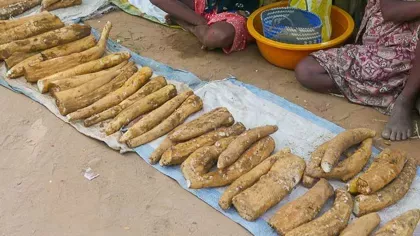Sustainable yam markets for conservation and food security in Madagascar
Increasing incomes and enhancing nutrition from wild and cultivated Malagasy yams to enhance livelihoods for rural communities and conserve wild yam species threatened by over-harvesting and habitat loss

Madagascan native yams comprise at least 45 species. Almost all are found nowhere else. They form a dietary starch resource that ranges from seasonal staples in specific regions to famine foods.
The yams are threatened by over-harvesting and habitat loss. A further species of cultivated yam (winged yam, Dioscorea alata) was introduced to Madagascar from Asia, and has potential to both improve lives and livelihoods and reduce wild yam harvesting if more extensively grown.
We aim to protect and enhance conservation successes achieved in the precursor project “Conserving Madagascar’s yams through cultivation for livelihoods and food security”. We are doing so via cultivating wild and winged yams and through providing business models at multiple scales, sustainable value chains, markets for processed tubers and nutritional information to guide policy. These interventions are improving food security, nutrition and livelihoods and conserving species.
- Natural Resources Institute, University of Greenwich
- Feedback Madagascar Ny Tanintsika
- University of Antananarivo Department of Fundamental and Applied Biochemistry
- Laboratory of Biochemistry Applied to Food Sciences and Nutrition (LABASAN)
Darwin Initiative (Ref: EIDPO049)
Leaflet on the effective storage of wild and winged yams
Leaflet manual for winged and wild yam cultivation
Leaflet manual for wild and winged yam nursery plantation techniques
Leaflet manual for seed collecting, population monitoring, cultivation and storage
Poster on wild and winged yams cultivation techniques
